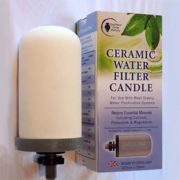How Do Water Filters Work & How Often Do They Need Changing
Water is excellent for dissolving things like dirt and minerals because it has an unusual molecular structure. This can, of course, be helpful in everyday life things like washing clothes or dishes, however, it can also have negative effects. Because water constantly mixes with the air and environment in what is known as the water cycle, it tends to pick up every type of contaminant you can imagine in the process of travelling from the clouds to your tap.
As water makes its journey to your drinking supply, it picks up all sorts of things from both the earth and the atmosphere, from chemicals and minerals to bacteria and parasites and the only real way to make sure these contaminants don’t end up in your body, is by filtering it before you drink it or use it.
Water Filters – How Do They Work?
There are two main types of filtration processes, and they are physical filtration (also known as mechanical) and chemical filtration.
- Physical filtration basically strains the water to remove larger impurities, in the same way a sieve or gauze filters things.
- Chemical filtration uses an active material that removes impurities through a chemical process as water is passed through it.
Water filters are constantly evolving, however the basic science behind it remains the same.
Mechanical or Physical Filtration
To explain this in simple terms, water contains many impurities, and they come in different sizes. The particles can include sediment, like lime, rust particles and lumps of dirt as well as parasites like cryptosporidium and giardia. Quality water filters, like the Southern Cross Pottery Ceramic Water Filters, will manually filter down to 1 micron in size, to ensure parasites like cryptosporidium and giardia (which are roughly 4.5 microns in size) don’t make it past. The first stage of the water filtration process is this 1-micron particle barrier.
Chemical Filtration
The second stage is called chemical filtration and this process improves the taste and smell of the water. Most tap water will be treated with chemicals like chlorine, to disinfect it, and kill the parasites mentioned above. The water also passes through underground pipes which can in some places be over 100 years old. Travelling through these pipes means that other particles can be picked up after they have already been removed from the water before it reaches our taps, and can also alter the taste of the water. This is where a carbon filter comes in.
How does it work?
Most water filters use an activated carbon block which features micro pores within the carbon that absorb tastes and odours, as well as removing chemicals like chlorine and fluoride. Other filter types include Ceramic water filters, which are created from natural clay, sand filters, and Diatomaceous earth filters.
How often should the filter be changed?
Depending on your local area, and how clean the water is, most filters will need to be changed at least every 12 months. The core of your filter can dissolve over time and it can also become blocked with limescale or other contaminants, so to keep the filter working efficiently it is important to change your water filter cartridge regularly.







Leave a Reply
Want to join the discussion?Feel free to contribute!